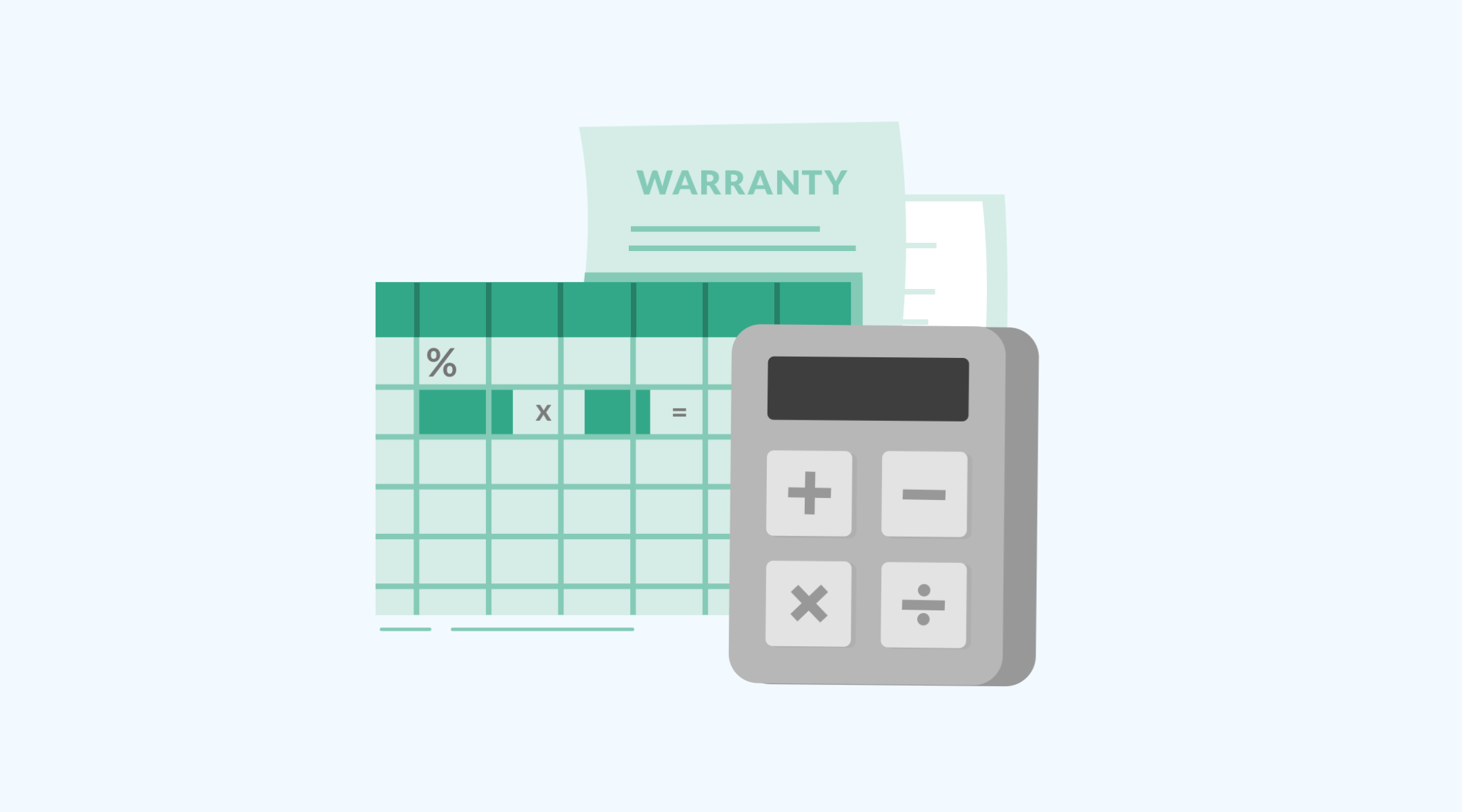What this guide covers:
Do you remember what your math teacher used to say? Show your work.
This practice is necessary when you go to purchase any operational software, including maintenance software. You need to track how you got from Point A to Point B to prove the value of your purchasing decision.
A good maintenance software will drive a return through cost benefits related to warranty, parts, labor, and asset management. With best-of-breed maintenance software and a quality implementation, it is not uncommon to see your full return on investment in one year through warranty reimbursements alone. This article will provide a deep dive into how to maximize your warranty reimbursement with maintenance software including which metrics to track to prove your return.
How do I calculate ROI for a Maintenance Software Investment?
As you already know a standard ROI equation usually looks something like this:
ROI %
=
Business benefits
Cost of Software purchase
Most organizations are looking for an ROI of somewhere over their cost of capital. This is typically about 20% or less. Sounds pretty simple, right? Of course, both cost of purchase and business benefits can be difficult to show without the right documentation. Let’s dig into that a little more.
BUSINESS BENEFITS
Here’s where ROI becomes most challenging to measure: not all business benefits are easily quantifiable. And, the benefits that an organization gets from maintenance software can span multiple areas: warranty, labor management, parts management, asset management, reduced safety hazards, etc. To effectively calculate the ROI, these benefits should be expressed as a cost benefit – i.e. translating the benefits to a dollar value.
The most common mistake around business benefits is inadequately documenting the “before” state. Later in this article, we’ll dive into key warranty metrics needed to document the before and after state and adequately quantify your return on investment.
COST OF SOFTWARE PURCHASE
This should include all costs directly associated with your maintenance software purchase: monthly or yearly subscriptions, personnel, training, implementation, hardware, and infrastructure costs. The largest risk to ROI can be a bloated implementation that drives up the cost of purchase – project delays, employee churn, data quality and capture issues, and scope creep stemming from changing requirements.
Most of these challenges can be avoided with due diligence: goal-setting, resource management, and project planning measures. The worst ROI-killer is simply selecting the wrong solution for your needs. Read Questions to ask before selecting a maintenance provider to understand how to weed out the wrong solution before you make a software purchase.
What do I need to track to prove Warranty ROI for maintenance software?
There are 3 major categories when it comes to warranty: OEM, parts replacement, and policy warranty. We’ll explore all the key metrics that need to be tracked to capture the data necessary to increase warranty reimbursement and the data needed to show an increase in warranty reimbursements following your purchase of maintenance software. It is also critical to document the total annual reimbursement before implementing software to show your work and prove a return. Use these metrics to ensure you’re capturing the right data to prove ROI before you implement a maintenance system.
What is an OEM Warranty?
OEM Warranty refers to any warranty agreement covered by the Original Equipment Manufacturer (OEM). There is no one size fits all approach to OEM warranties. So much of what you can capture is dependent on asset type or the specific warranty agreements you have in place with OEMs. Though guidelines will vary, OEM, suppliers, and manufacturers generally look for the same types of information. Capturing all of the metrics listed below will increase the likelihood of reimbursement.
METRICS FOR OEM WARRANTY
If you perform maintenance in house:
- Capture details around labor and part costs
- Just about all OEM’s care about the Three Cs: Complaint, Cause, and Correction
- Complaint: why did the truck come in for repair?
- Cause: what was the problem?
- Correction: how was the problem solved?
If you outsource maintenance:
- Be meticulous about documenting what the actual cost was to track the dollars saved
- Ensure that the dealer is OEM certified to complete warrantable repair
If you use a combination of in-house and outsourced labor:
- Document when the truck was placed in service, meter data, fail date, and the three Cs outlined above
- Compile labor and part info from the repair
- Track downtime, repair times, and impacts to asset availability to make a case for reimbursement to OEMs
- Capture towing costs which are often covered under warranty
- Overall, measure the effectiveness of your warranty agreements by tracking and comparing the cost of the agreement and reimbursement rates. If you don’t, you may end up overpaying on warranty. Compare the cost of OEM vs Manufacturer component warranty to help inform future purchasing decisions.
What is a parts replacement warranty?
A warranty agreement outlining the OEM, Manufacturer or Supplier’s coverage of parts requiring replacement during the warranty term.
METRICS FOR PARTS REPLACEMENT WARRANTY
- Store parts replacement warranty agreements
- Document all part failures
- Track parts usage and part position data. This saves time, helps increase chances of reimbursement, and gives visibility into failure trends based on position and usage.
- Ensure you capture overall part spend so you can measure it against your Parts Replacement warranty returns. A benchmark we recommend is that you should be getting 3-6% of your parts spend back on Parts Replacement warranty
What is policy warranty?
If you track and document failure information, and you notice that a number of assets fail a short amount of time after warranty has expired, this data can be used to hold OEMs accountable and get a reimbursement – this is sometimes known as a policy warranty.
METRICS FOR POLICY WARRANTY
- It is especially critical to track failures that occur 30 days after the asset’s warranty has expired
- Document failure trends over time to back up a claim when an asset or part is defective
- Beyond the data, ensure a relationship is being built between the OEM and the shop’s liaison
- It can be easiest for larger organizations with high asset counts to collect enough data to prove failure trends
- Buying power can increase the likelihood of a policy claim reimbursement. But, small to medium size fleets with less buying power can still make a successful claim by combining failure data just outside of warranty with trends from other industry peers. This is another reason why networking and collaboration is undervalued in our space. Get together and consolidate trend data with other groups at industry events or online forums (like the TMC or the Cetaris Steering Committee)
How to calculate Warranty ROI?
METRICS FOR CALCULATING WARRANTY ROI
- Number of warrantable assets
- Warranty return before using maintenance software
- Average warranty return per asset after using maintenance software
- Total software spend
Warranty ROI and total warranty reimbursement increase can be calculated with these simple equations:
Warranty ROI %
=
Annual Warranty Return Before Maintenance Software
–
Annual Warranty Return After Maintenance Software
Cost of Investment
Warranty Increase
=
Annual Warranty Return After Maintenance Software
−
Annual Warranty Return Before Maintenance Software
Warranty % Increase
=
Warranty Increase
Annual Warranty Return Before Maintenance Software
x 100
Fleet Maintenance Software built for ROI
I know, I know! Those are a lot of metrics to keep track of…Which is why it’s imperative that you choose the right tool. One that collects data, streamlines costs, and optimizes processes. A tool that’s built to show your work and prove its own value
The good news is that
 is designed to collect all this data and more for you. Are you looking for a maintenance system that captures quality data and automates work order creation and PM scheduling? Cetaris optimizes your maintenance while driving ROI.
is designed to collect all this data and more for you. Are you looking for a maintenance system that captures quality data and automates work order creation and PM scheduling? Cetaris optimizes your maintenance while driving ROI.
 !
!







